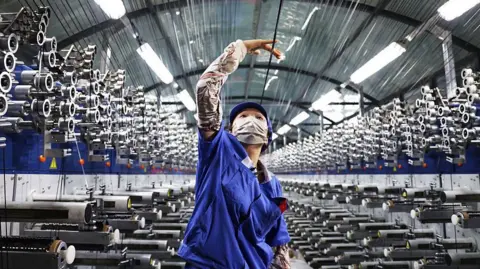**Trump Tariffs on Asia: Which Economies Were Hit Hardest?**
In April, US President Donald Trump made headlines with significant tariffs aimed at various Asian economies, calling this moment “Liberation Day”. The impact of these tariffs reverberated throughout the region, notably affecting nations that heavily depend on exports to the United States. This article outlines the economic landscape post-tariff imposition, highlighting the countries that bore the brunt of these financial measures.
Asian economies have been among the hardest hit by the tariffs, which has resulted in a scramble for negotiations before an impending deadline of August 1. Traditional US allies such as Japan, South Korea, and Australia faced the bite of these trade penalties. With the overarching question of how each nation fared now at hand, it’s crucial to examine the circumstances for these economies.
**US Allies: South Korea, Japan, Taiwan, Australia**
The repercussions of the tariffs varied among America’s key allies. Japan and South Korea, recognized for their essential exports like automobiles and semiconductors, were initially threatened with a proposed 25% tariff. However, their longstanding military connections and economic negotiations helped mitigate the blow. By the end of July, the proposed tariffs were adjusted down to 15%, showcasing the efficacy of trade delegations and dialogues with Washington.
In a noteworthy announcement on July 22, Trump celebrated the reduced tariffs on Japanese goods, labeling it as the “largest trade deal in history.” Similarly, the agreement with South Korea was finalized on July 30. Taiwan, a major manufacturer of semiconductors, witnessed its tariffs reduced from 32% to 20%, although it remains uncertain if the chip industry will face additional tariffs. Meanwhile, Australia faced a 10% tariff, avoiding any proposed increases, contrasting with New Zealand, which saw its tariff rise from 10% to 15%.
**What About China and India?**
Conversely, China, which notably escaped immediate tariff updates in this cycle, remains a predominant factor in the trade discussions. Recent diplomatic engagements between Washington and Beijing have pointed toward a search for mutual concessions, including possible reductions in US export controls on technology in exchange for rare earth minerals. The US has also vocalized expectations about China’s commitment to curb the production of fentanyl and improve market access for American enterprises.
India, classified by Trump as a “good friend,” found itself struggling under a 25% tariff on imports, compounded by an ambiguous penalty related to its transactions involving Russian oil. This tariff represents a slight decrease from an initial 27% proposed previously. Secretary of State Marco Rubio indicated the enduring dilemmas within the India-US relationship, highlighting concerns about Delhi’s ties with Moscow.
**ASEAN Countries Face Different Outcomes**
The nations of Southeast Asia, grouped under the ASEAN umbrella, have encountered divergent outcomes post-tariff implementation. With a strong reliance on export-driven economies, the initial announcement of tariffs was met with fear and shock, as rates climbed as high as 49% for certain countries. Among this bloc, Vietnam emerged as the primary negotiator, successfully reducing its tariff rate from an alarming 46% to 20%, consequently setting the standard for neighboring countries.
However, countries like Cambodia and Thailand experienced significant unfavorability. Most of the ASEAN members now face tariffs ranging between 19% to 20%, while Brunei stands apart with a slightly higher penalty of 25%. Strikingly, Laos and Myanmar are facing the harshest tariffs at 40%, raising questions about the White House’s decision-making process.
**How Did Other Countries in the Region Fare?**
Tariff rates across the Indo-Pacific region showcase varying levels of exposure. Pakistan, benefiting from improved relations with the US, enjoys the lowest tariff at 19%, enhancing its textile industry’s competitive edge. On the contrary, countries such as Afghanistan, Fiji, and Papua New Guinea face a standard 15% rate.
Dr. Deborah Elms points out the lack of finality behind the announced rates, as President Trump retains the authority to amend them based on ongoing dialogues and evolving situations. This fluid landscape signifies that economic relationships may shift rapidly depending on the political environment.
In conclusion, the recent tariffs imposed by the Trump administration underscore significant implications for key Asian economies, reflecting varied impacts across the region. As nations navigate these economic waters, the evolving trade dynamics will likely continue to shape diplomatic relations and economic strategies well into the future.












